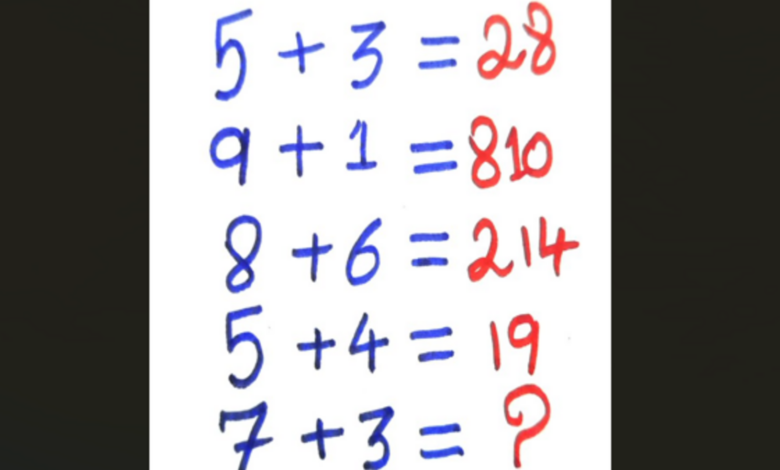Brain teaser: If you crack this tricky maths riddle, you’ll be on the l of top IQ achievers | Trending

Brain teasers have always been a favourite pastime for puzzle enthusiasts, but those involving mathematics tend to spark even greater curiosity. These challenges not only test one’s numerical skills but also push logical reasoning to its limits. If you’re someone who loves solving mathematical brain teasers, here’s a fresh one to put your mind to the test! A maths brain teaser puzzled users on X.(X/@brainyquiz_) (Also read: Brain teaser: If you crack this tricky maths riddle, you’ll be officially titled champ of the day) The latest brain teaser that has the internet hookedA new mathematical puzzle has been shared on X (formerly Twitter) the account @brainyquiz_, leaving users intrigued and eager to decode its logic. The puzzle reads: “5 + 3 = 28, 9 + 1 = 810, 8 + 6 = 214, 5 + 4 = 19, 7 + 3 = ?” Check out the puzzle here: At first glance, these equations don’t seem to follow traditional mathematical rules, but that’s exactly what makes them so exciting! Solvers must think outside the box to uncover the hidden pattern behind these numbers. Another puzzle that left many scratching their headsThis isn’t the first time @brainyquiz_ has stumped social media users with a tricky maths teaser. A previous puzzle from the same account also went viral, challenging people to find the logic behind these unusual equations: “98% Can’t Solve This: 22 + 4 = 24, 13 + 6 = 16, 80 + 2 = 82, 67 + 9 = ??” Many users shared their attempts, with some confidently cracking the code while others were left baffled. The challenge lies in recognising patterns and identifying unconventional mathematical relationships rather than relying on standard arithmetic rules. (Also read: Brain teaser: You’ll be crowned genius of the day if you solve this tricky maths puzzle in 20 seconds) Why do maths brain teasers go viral?Mathematical brain teasers captivate the internet for a simple reason—they challenge conventional thinking. Unlike straightforward arithmetic, these puzzles require lateral thinking and problem-solving skills. They create a sense of competition, with users racing to be the first to crack the logic behind them. Moreover, they offer an engaging way to exercise the brain, improving cognitive skills and logical reasoning. The thrill of solving a seemingly impossible equation keeps users coming back for more.






